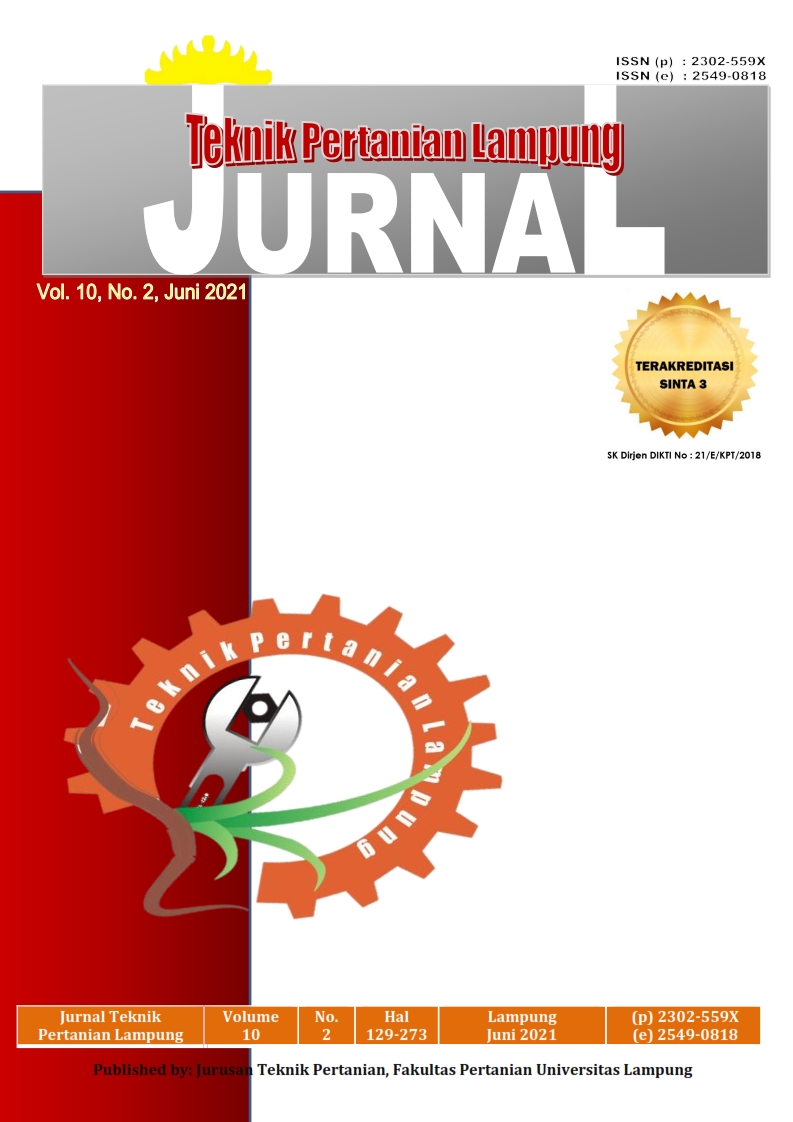DAYA TAMPUNG SUNGAI REMBAGAN TERHADAP BEBAN PENCEMARAN MENGGUNAKAN METODE STREETER-PHELPS
DOI:
https://doi.org/10.23960/jtep-l.v10i2.209-219Abstract
Rembagan River is the main tributary of the Bedadung River in Cangkring Village, Patrang District, Jember Region. Various community activities in the Rembagan River area such as bathing, washing, defecating and urinating as well as agricultural activities will produce domestic and agricultural waste. These wast can cause river water pollution, especially water quality degradation. then the research needs to be done an analysis of the capacity of the Rembagan River in receiving pollution costs. The purpose of this study is to find out how much the ability of the Rembagan River to accept the burden of pollutants using the Streeter-Phelps method. Streeter-Phelps modeling takes into account two phenomena, namely the process of measuring dissolved oxygen (deoxygenation) and the process of increasing dissolved oxygen (reaeration). The results obtained from these calculations are oxygen drop curves determined on the basis of oxygen deficit values. The average values of deoxygenation rate and reoxygenation rate were sequentially 1.58931 mg/L/day and 10.09982 mg/L/day. So that self-purification can run well which means the water quality of the Rembagan River was still relatively good. This can be seen in the DO model pattern that goes up in each segment. The actual DO of 5.6760 mg / L was greater than the DO standard of class III quality of 3 mg / L. It can be interpreted that the Rembagan River still has a remaining DO of 2.676 mg / L and was still able to accept pollution cost of 18.8 kg/day.
Keywords: pollution load, Rembagan River, river capacity
References
Arbie, R. R., Nugraha W. D., dan Sudarno. 2015. Studi Kemampuan Self Purifunction Pada Sungai Progo Ditinjau Dari Parameter Organik DO dan BOD (Point Source : Limbah Sentra Tahu Desa Tuksono, Kecamatan Sentelo, Kabupaten Kulon Progo, Provinsi D. I. Yogyakarta). Jurnal Teknik Lingkungan, 4(3): 1-15.
Astono, W. 2010. Penetapan Nilai Konstanta Dekomposisi Organik (Kd) dan Nilai Konstanta Reaerasi (Ka) Pada Sungai Ciliwung Hulu – Hilir. Jurnal Ekoksains, 2(1), 40-45.
Ayudina, A. 2017. Penentuan Nilai Koefisien Laju Deoksigenasi Sungai Citarum Segmen Tengah, Jurusan Teknik Lingkungan, Fakultas Teknik, Universitas Pasundan. Diakses dari http://repository.unpas.ac.id/27824/1/ABSTRAK.docx. [Diakses pada 27 Agustus 2019].
Dharmawan, A., Wahyuningsih, S. dan Novita, E. 2020. Laju Deoksigenasi Sungai Bedadung Hilir Akibat Pencemar Organik. Jurnal Teknologi Lingkungan, 21(1). 109-117.
Keputusan Menteri Negara Lingkungan Hidup Nomor 110. 2003. Pedoman Penetapan Daya Tampung Beban Pencemaran Air Pada Sumber Air. Jakarta: Kementrian Lingkungan Hidup.
Keputusan Menteri Negara Lingkungan Hidup Nomor 122. 2004. Baku Mutu Limbah Cair Bagi Kegiatan Industri. 12 Agustus 2004. Jakarta.
Marganingrum, D., M. R. Djuwansah, dan A. Mulyono. 2018. Penilaian Daya Tampung Sungai Jangkok dan Sungai Ancar terhadap Polutan Organik. Jurnal Teknologi Lingkungan, 19(1): 71 – 80.
Rahayu, S., dan Tontowi. 2009. Penelitian Kualitas Air Bengawan Solo pada saat Musim Kemarau. Jurnal Sumber Daya Air, 5(2):127-136.
Rahayu, S., R. H. Widodo, M. V. Noordwijk, I. Suryadi, dan B. Verbist. 2009. Monitoring Air di Daerah Aliran Sungai.Available at:http;//www.worlda groforestry.org/download/Publications/PDFS.B16396.Rahmawati, D. 2011. Pengaruh Kegiatan Industri Terhadap Kualitas Air Diwak di Bergas Kabupaten Semarang dan Upaya Pengendalian Pencemaran Air Sungai. Tesis. Universitas Diponegoro, Semarang.
Ryadi, S. 1984. Pencemaran Air. Surabaya: Karya Anda.
Downloads
Published
Issue
Section
License
- Authors who publish with this journal agree to the following terms:
- Authors retain copyright and grant the journal right of first publication with the work simultaneously licensed under a Creative Commons Attribution-ShareAlike 4.0 International Lice that allows others to share the work with an acknowledgement of the work's authorship and initial publication in this journal.
- Authors are able to enter into separate, additional contractual arrangements for the non-exclusive distribution of the journal's published version of the work (e.g., post it to an institutional repository or publish it in a book), with an acknowledgement of its initial publication in this journal.
- Authors are permitted and encouraged to post their work online (e.g., in institutional repositories or on their website) prior to and during the submission process, as it can lead to productive exchanges, as well as earlier and greater citation of published work (See The Effect of Open Access).
Jurnal Teknik Pertanian Lampung

JTEPL is licensed under a Creative Commons Attribution-ShareAlike 4.0 International License.

